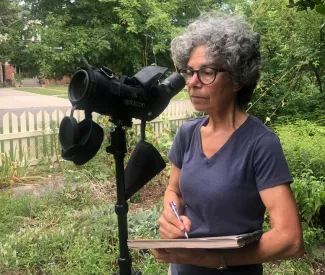
Debby Kaspari sketches visiting Mississippi kites from life in her Norman front yard.
Artist Debby Kaspari may have grown up in northern California, but her early years were linked to Oklahoma through a childhood hero, George M. Sutton. Sutton, a legend in the bird world for both his research and artwork, spent his final three decades in Oklahoma studying our bird life. Kaspari’s eventual move to Norman, the city Sutton had called home, was purely coincidence when she met and married future University of Oklahoma biology professor Mike Kaspari. But her current home serves as yet another connection to her early hero.
As in Sutton’s artwork, birds are the primary subject of Kaspari’s sketches. And while she’s traveled extensively for her work, Kaspari also finds artistic inspiration in the native plants and animals found in and around her Norman neighborhood.
“I was able to start a new project last summer, drawing visiting Mississippi kites, without leaving my yard,” Kaspari said. “The kites would preen and hunt for frogs and insects from a nearby tree that had multiple bare branches. I probably have more than 150 sketches of those birds. I was just drawing for hours.”
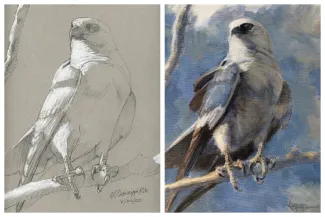
Drawing of a Mississippi kite, made through the scope, and finished “Kite in the Wind” oil on canvas, painted in the studio based on life-sketches.
To better view and capture the birds’ gestures and poses, Kaspari set up a scope in her front yard.
“When you draw, you need to take in all the little details. The scope helps me see so many elements that I may miss with the naked eye.”
Kaspari’s initial sketches are often done quickly, and are considered more “gesture drawings” than “measured drawings” that may not always accurately reflect the bird’s proportions or dimensions. Once she has the foundation of the sketch, she then fills in the finer details, and often refers to field guides, photo reference, and drawing tutorials, like those from John Muir Laws, or Tim Wootton. She’s even visited the Sam Noble Museum to learn from the bird skins collected by George M. Sutton.
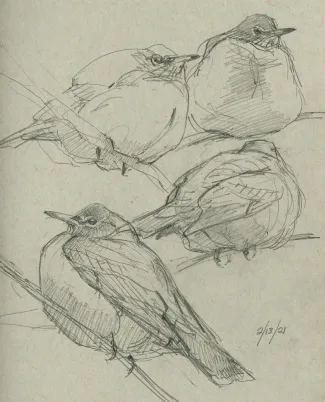
“Round Robins,” life-sketched through a window during the February 2021 deep-freeze. Robins trying to stay warm by puffing out their feathers like down jackets.
To attract her sketchbook subjects, Kaspari leans heavily on the habitat found in her yard and neighborhood.
“We have native wildflowers, shrubs and trees in our yard, and the birds and other wildlife use those tangles to hide, eat, and even nest. We also have a low-flow bird bath dripper; the sound of water really draws in the birds.”
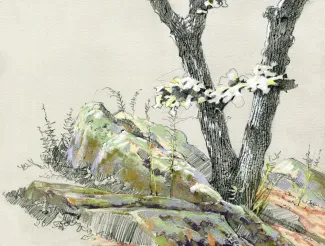
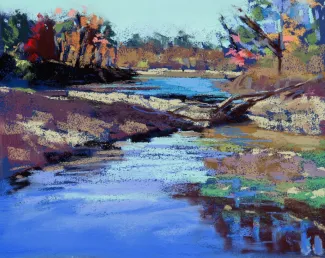
The Kaspari’s landscaping is based on Oklahoma’s native habitat. “Crosstimbers” plein air (on location) drawing using pencil and pastels on toned paper above, and plein air pastel of the Kiamichi River headwaters in southeastern Oklahoma below.
For aspiring artists, Kaspari recommends practice.
“You really don’t need anything more than a sketchbook and pencil. Just get outside and explore anything that catches your eye. Use the time with your sketchbook to improve your hand-eye coordination and to get a better sense of whatever it is that you choose to draw.”
Kaspari’s work has been featured in Oklahoma Today and Bird Watcher’s Digest, and displayed at the Sam Noble Museum. Connect with her, browse her sketchbooks, and check out her blog at drawingthemotmot.com.
Kaspari is just one of many naturalists furthering our understanding and appreciation of Oklahoma’s fish and wildlife. Find more inspiring #WomenInWildlife on our social media channels @OKWildlifeDept.